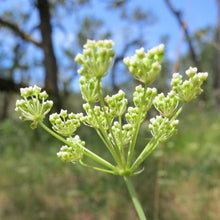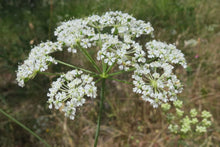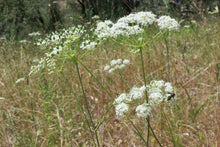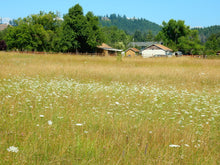
Perideridia oregana
Oregon yampah, also known as eppaw, is a perennial wildflower in the carrot family that has been an important food source for first nation people and is beloved by pollinators. It can vary in appearance, but always flaunts a compound umbel of many spherical clusters of small white flowers, in late spring and early summer, that resembles Queen Anne’s lace.
This species was once much more prevalent in the Willamette Valley. But today, prairies or open grasslands are among the most threatened ecosystems in Oregon due to invasive weeds and habitat destruction (aka “development”). Plant yampah in your home garden and grow a gorgeous piece of this important ecological and cultural heritage at home.
- Plant type/canopy layer: deciduous, perennial, herbaceous plant
- Size at maturity: 4 - 36” tall, 6” wide
- Light requirements: full sun, part sun/part shade
- Moisture requirements: dry soil, moist soil, wet soil; any texture
- Bloom time: May-July
- Growth rate/ease: medium growth rate, easy to grow
- Wildlife support: flowers attract and provide nectar to adult bees, butterflies and other insect pollinators; overall plant is a caterpillar host and larval food source for native butterflies and moths including the Anise Swallowtail
- Native habitat/range: grows in open places such as oak woodlands, upland prairies, savannas, wet prairies and openings/edges of lodgepole pine, red fir and yellow pine forests, from the most southwestern areas of Washington, throughout western Oregon and into northern California. Portland Plant List - no.
- Special features & uses: drought tolerant; functions beautifully as a cut flower; all parts edible; roots are high in vitamin c, protein, and potassium, eaten fresh they are juicy and sweet like a water chestnut, when cooked they become nutty and sweet; large green seeds have a flavor very similar to caraway, fresh or dried (never eat a wild plant unless you are 100% certain of its identity); landscape uses include meadowscapes and pollinator gardens
Gardening with Oregon Yampah: This sweet little wildflower works beautifully when planting in clumps or drifts throughout meadowscapes or other sunny garden areas. It is a diminutive plant and needs strength in numbers to hold up against other, more dominant perennials. It’s not too picky about soil type, able to tolerate a range of moisture and texture conditions, including drought conditions. Be sure to water it the first summer or two, then it will prove to be among the hardiest and pollinator-attracting in your garden.
Photo Credits: © Ed Alverson, some rights reserved (CC-BY)







